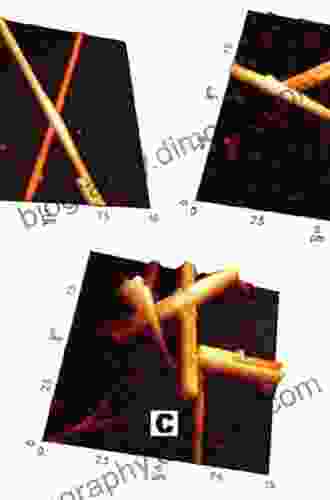Unveiling the Power of Nanotechnology and Enzymes: Revolutionary Solutions to Environmental Challenges

As the world grapples with the devastating impacts of environmental degradation, scientists and engineers are turning to innovative technologies to find groundbreaking solutions. Among these promising advancements, nanotechnology and enzymes stand out as powerful tools in our arsenal to combat environmental challenges and create a more sustainable future.
5 out of 5
| Language | : | English |
| Hardcover | : | 138 pages |
| Item Weight | : | 15.2 ounces |
| Dimensions | : | 7.52 x 0.46 x 9.25 inches |
| File size | : | 11974 KB |
| Text-to-Speech | : | Enabled |
| Screen Reader | : | Supported |
| Enhanced typesetting | : | Enabled |
| Print length | : | 70 pages |
| Lending | : | Enabled |
| Paperback | : | 199 pages |
Nanotechnology: A Realm of Tiny Solutions
Nanotechnology involves the manipulation and engineering of materials at the nanoscale, where one nanometer is one billionth of a meter. At this incredibly small scale, materials exhibit unique properties that differ from their macroscopic counterparts. These unique properties enable the development of novel materials and devices with exceptional capabilities for environmental applications.
One of the most significant advantages of nanotechnology is its ability to enhance the reactivity and efficiency of catalytic processes. Catalysts are substances that accelerate chemical reactions without being consumed themselves. Nanoparticles, which are ultra-small particles with dimensions in the nanometer range, can be tailored to exhibit high surface area-to-volume ratios, providing abundant active sites for catalytic reactions.
In environmental applications, nanotechnology-based catalysts can play a crucial role in air and water purification, breaking down pollutants and converting them into harmless substances. For example, titanium dioxide (TiO2) nanoparticles have been shown to effectively degrade volatile organic compounds (VOCs),nitrogen oxides (NOx),and particulate matter (PM) from industrial emissions.
Additionally, nanotechnology offers promising solutions for water treatment. Nanofiltration membranes, which are made up of nanopores with precisely controlled sizes, can effectively remove contaminants, bacteria, and viruses from water sources. This technology holds great potential for providing clean drinking water to underserved communities and reducing waterborne diseases.
Enzymes: Nature's Catalytic Powerhouses
Enzymes are proteins that catalyze specific biochemical reactions in living organisms. They play a vital role in various cellular processes, including metabolism, digestion, and DNA replication. In environmental applications, enzymes can be harnessed to degrade pollutants, remediate contaminated sites, and produce renewable energy sources.
One of the key advantages of enzymes is their high specificity. They can selectively target and break down specific pollutants without affecting other components in the environment. This targeted approach minimizes the potential for unintended consequences and environmental harm.
Enzymes have been successfully employed in bioremediation efforts to clean up contaminated soil and groundwater. For example, enzymes such as lignin peroxidase and laccase can break down petroleum hydrocarbons and other organic pollutants into harmless compounds. These enzymes can be applied to contaminated sites, where they gradually degrade the pollutants over time.
In the realm of renewable energy, enzymes are being explored for the production of biofuels. Cellulases, for instance, can break down plant biomass into fermentable sugars, which can then be converted into bioethanol or biodiesel. This enzyme-assisted biofuel production process offers a sustainable alternative to fossil fuels, reducing greenhouse gas emissions and promoting energy independence.
Synergistic Fusion: Combining Nanotechnology and Enzymes
The combination of nanotechnology and enzymes creates a powerful synergy that further enhances their environmental applications. By integrating nanoparticles with enzymes, scientists can design hybrid materials that combine the unique properties of both technologies.
One promising application of this hybrid approach is in the development of biosensors for environmental monitoring. Enzyme-functionalized nanoparticles can be used to detect specific pollutants in air, water, or soil samples. These biosensors offer high sensitivity and selectivity, enabling real-time monitoring of environmental quality.
Another area where the fusion of nanotechnology and enzymes holds great potential is in the production of self-cleaning materials. By incorporating enzymes into nanostructured coatings, surfaces can be engineered to break down pollutants upon exposure to sunlight or other stimuli. This technology could revolutionize the design of buildings, vehicles, and other infrastructure, reducing air pollution and improving public health.
The convergence of nanotechnology and enzymes opens up a new chapter in environmental science, offering innovative solutions to pressing environmental challenges. From air and water purification to renewable energy production and bioremediation, these technologies hold the promise of creating a more sustainable and healthy planet for generations to come.
As research continues to advance, we can expect even more groundbreaking applications of these technologies, unlocking the full potential of nanotechnology and enzymes to safeguard our environment and ensure a sustainable future.
5 out of 5
| Language | : | English |
| Hardcover | : | 138 pages |
| Item Weight | : | 15.2 ounces |
| Dimensions | : | 7.52 x 0.46 x 9.25 inches |
| File size | : | 11974 KB |
| Text-to-Speech | : | Enabled |
| Screen Reader | : | Supported |
| Enhanced typesetting | : | Enabled |
| Print length | : | 70 pages |
| Lending | : | Enabled |
| Paperback | : | 199 pages |
Do you want to contribute by writing guest posts on this blog?
Please contact us and send us a resume of previous articles that you have written.
 Book
Book Novel
Novel Page
Page Chapter
Chapter Text
Text Story
Story Genre
Genre Reader
Reader Library
Library Paperback
Paperback E-book
E-book Magazine
Magazine Newspaper
Newspaper Paragraph
Paragraph Sentence
Sentence Bookmark
Bookmark Shelf
Shelf Glossary
Glossary Bibliography
Bibliography Foreword
Foreword Preface
Preface Synopsis
Synopsis Annotation
Annotation Footnote
Footnote Manuscript
Manuscript Scroll
Scroll Codex
Codex Tome
Tome Bestseller
Bestseller Classics
Classics Library card
Library card Narrative
Narrative Biography
Biography Autobiography
Autobiography Memoir
Memoir Reference
Reference Encyclopedia
Encyclopedia Matthew Paul Turner
Matthew Paul Turner Allen Barton
Allen Barton Rod Kuratomi
Rod Kuratomi Tracey Turner
Tracey Turner Graham Warren
Graham Warren Alfio Quarteroni
Alfio Quarteroni Rob Steen
Rob Steen Alyssa Nolte
Alyssa Nolte Alexei V Finkelstein
Alexei V Finkelstein Easton Livingston
Easton Livingston Alan Rose
Alan Rose Lurlene Mcdaniel
Lurlene Mcdaniel Allen B Simons
Allen B Simons Allen Maslen
Allen Maslen Alice Kinerk
Alice Kinerk Danielle L Jensen
Danielle L Jensen Ali H Sayed
Ali H Sayed Amina N
Amina N J M Parker
J M Parker Adam Silvera
Adam Silvera
Light bulbAdvertise smarter! Our strategic ad space ensures maximum exposure. Reserve your spot today!

 Ashton ReedUnleash the Extraordinary World of Fullerene Nanowhiskers by Alvaro Tucci: A...
Ashton ReedUnleash the Extraordinary World of Fullerene Nanowhiskers by Alvaro Tucci: A... Pablo NerudaFollow ·4.7k
Pablo NerudaFollow ·4.7k Warren BellFollow ·13.5k
Warren BellFollow ·13.5k Yukio MishimaFollow ·13.5k
Yukio MishimaFollow ·13.5k Hector BlairFollow ·4.5k
Hector BlairFollow ·4.5k Jamal BlairFollow ·19.3k
Jamal BlairFollow ·19.3k Derek BellFollow ·14.8k
Derek BellFollow ·14.8k Harvey HughesFollow ·16.2k
Harvey HughesFollow ·16.2k Griffin MitchellFollow ·7.6k
Griffin MitchellFollow ·7.6k

 Darnell Mitchell
Darnell MitchellMathematician's Odyssey to Uncover the Origins of Numbers
In his captivating new...

 Milton Bell
Milton BellUnlock the Power of Profiting Without Property: Your...
Are you ready to embark on a...

 Arthur Mason
Arthur MasonUnlock the Minds of Mathematical Giants: The Lives of the...
Mathematics, the language of...

 Fernando Pessoa
Fernando PessoaUnlock the Magic of the Big Apple: New York City for...
Unleash the Adventures in New...

 H.G. Wells
H.G. WellsAddiction Counselor Exam Secrets Study Guide: Your...
Embark on a...
5 out of 5
| Language | : | English |
| Hardcover | : | 138 pages |
| Item Weight | : | 15.2 ounces |
| Dimensions | : | 7.52 x 0.46 x 9.25 inches |
| File size | : | 11974 KB |
| Text-to-Speech | : | Enabled |
| Screen Reader | : | Supported |
| Enhanced typesetting | : | Enabled |
| Print length | : | 70 pages |
| Lending | : | Enabled |
| Paperback | : | 199 pages |












